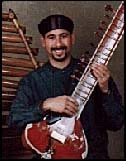

The sitar from North India is an 18-stringed lute type instrument with 7 main strings played above movable frets, while the 11 remaining strings (sympathetic strings) vibrate below the frets. It’s components are a hollow wooden neck attached to a pumpkin-shaped gourd.
A distinctive feature of the sitar are the curved frets (bunds), which are movable (allowing fine variation in tuning) and raised (so that resonant strings can run underneath the frets). A typical sitar has 18, 19 or 20 strings (depending on the style) of which 6 (in the Vilayat Khan style) or 7 (in the Ravi Shankar style) are playable strings, which are situated over the frets. Three of these strings (chikari) provide the drone and the rest are used to play the melody, though most of the notes of the melody are played on the first string (baj tar). The sitar also has 11, 12 or 13 sympathetic strings or tarbs running underneath the frets.
The instrument has 2 bridges; the main bridge (bada goraj) for the playing and drone strings and a smaller, secondary bridge (chota goraj) for the sympathetic strings that run beneath the main strings. The sitar may or may not have a secondary resonator, the tumba, near the top of its hollow neck. The sitar's distinctive sound is a result of the way the strings interact with the wide, sloping bridge. This is in contrast to the bridge on a guitar which resembles a knife edge. In a sitar, as a string vibrates, its length changes slightly as its edge touches the bridge, promoting the creation of overtones and giving the sound its distinctive, rich tone. The maintenance of this specific tone by shaping the bridge is called "jawari". Adjusting the jawari requires great skill. Many professional musicians will rely on professional instrument makers to perform this task. For years, Ravi Shankar toured the West with his sitar maker so that the tone of his sitar was always perfectly adjusted.
The materials used in construction include teak or tun wood (Cedrela tuna), which is similar to mahogony, for the neck and faceplate, and gourds for the kaddu (the main resonating chamber). The instrument's bridges are made of deer horn, ebony, or very occasionally from camel bone or elephant ivory.
Tuning
The tuning of a sitar varies depending on school or style. Generally, the main playing string is tuned to C# or D, and the drone strings are tuned to the equivalent of an open major or minor chord in Western music theory. The specific tuning for each raga is determined by tradition and each artist's personal preference. The sympathetic strings are tuned to the notes of the raga being played, although there is slight stylistic variance as to the order of these. The player will usually re-tune the sitar for each raga.
The strings are tuned by turning the pegs that hold the strings. The main playing strings are fine-tuned by sliding a bead fit around each string.
It may be rather difficult to tune a sitar. Not only because of the numerous strings (a typical guitar only has six strings) or the lack of geared mechanical tuners (sitar tuning pegs are wood cylinders that are chalked and tightened into a hole like traditional western classical music instruments such as the cello), but also because there are many different tunings, each based on the cadre of traditional and emerging tonal patterns or on the music of eminently influential sitar players.
In one or more of the more common tunings (used by Ravi Shankar, among others, called "Kharaj Pancham" Sitar) the strings are different in this fashion: The Chikari, Sa (high) Sa (middle) Pa. The Kharaj strings (bass strings) Sa (low) Pa. Then "jod" and "baaj" string, Sa and Ma. When playing a Vilayat Khan Sitar (or "Gandhar Pancham" Sitar), the bass or "kharaj" strings are removed and in their place is a 4th Chikari which is tuned to Ga, when playing the chikari you produce a chord (Sa, Sa, Pa, Ga). The sympathetic strings (tarif) are tuned depending on the raga, although for most purposes, they are tuned: Sa, Ni, Sa, Re, Ga, Ma, Pa, Pa, Dha, Ni, Sa, Re, Ga, (last three in the upper range). If you were to tune it to rag Kafi for example you use tune as follows: Sa, ni (lower case denotes flat or, more properly, "komal") Sa, Re, ga, Ga (Shuddh ("natural"), considering that in Kafi you will come to Shuddh Ga when descending or "avarohi"), ma, Pa, Dha, ni, Sa, Re, ga. Whereas, in ragini Yaman Kaylan you will tune the Tarifs to Sa, Ni, Sa, Re, Ga, ma (Yaman Kaylan asks for a sharp, or more properly, "tivra" Ma, but often will touch shuddh ma on the descent or "avarohi"), Ma, Pa, Dha, Ni, Sa, Re, Ga. Again, however, there is a lot of stylistic variance to these tunings. An artist will develop a particular tuning for a particular piece and it may be totally idiosyncratic. There is no guarantee that other musicians will choose the same tuning even if they perform the same raga.
![]() Back to Home
Page
Back to Home
Page